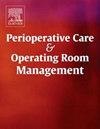The benefits from the video laryngoscope on postoperative sore throat: A randomized controlled trial
IF 1
Q2 Nursing
Perioperative Care and Operating Room Management
Pub Date : 2025-09-26
DOI:10.1016/j.pcorm.2025.100560
引用次数: 0
Abstract
Background
Postoperative sore throat (POST) is a frequent complication of orotracheal intubation. The aim of our study was to assess the impact of video laryngoscopy (VL) type McGrath on postoperative sore throat following surgery with intubation.
Methods
This was a prospective, randomized study conducted over a 9 months period. We included 136 patients with non-difficult airway, with American Society of Anesthesiologists classification 1 to 3 and over 18 years old. The patients were randomized into two groups: the DL group including 70 patients intubated with a direct laryngoscope (DL) and the VL group including 66 patients intubated with a VL. Our primary outcome was POST assessed by a pain scale from 0 to 10 at 6 h postoperatively. We also evaluated the dysphonia and dysphagia, cough at emergence of anesthesia and Cormack and Lehane classification as secondary outcomes.
Results
Patients’ demographic and anthropometrical characteristics were comparable, as well as medical history. POST 6 h after surgery was lower in VL group: 0 [0–1.25] (Min:0 – Max:3) versus 2 [2–3] (Min:0 – Max:6) (p < 0.001). Pain scores were also lower in DL group at H1, H2, H12 and H24 (p < 0.001). Hoarseness at H12 (32.4 % versus 15.2 %; p = 0.02) and dysphagia at H2 (17.1 % versus 4.5 %; p = 0.02) were less frequent in VL group. Cough at emergence of anesthesia and hemodynamic response to intubation were comparable between the two groups. Difficult laryngoscopies were less frequently encountered in VL group (p = 0.007). Multivarious analysis assessed the impact of direct laryngoscopy, with adjusted OR = 8.5 [3.6; 19.8] and p < 0.001. The subgroups analysis showed that the use of VL reduced POST among female and patients with body mass index over 25 kg/m2 (p < 0.001).
Conclusion
The use of the VL reduces POST, dysphonia and dysphagia. It also reduces the incidence of difficult laryngoscopies among patients with non-difficult airway.
视频喉镜治疗术后喉咙痛的疗效:一项随机对照试验
背景术后喉咙痛(POST)是口气管插管的常见并发症。本研究的目的是评估视频喉镜(VL)型McGrath对插管手术后喉咙痛的影响。方法:这是一项为期9个月的前瞻性随机研究。我们纳入136例无气道困难患者,年龄在18岁以上,按美国麻醉医师协会分类1 - 3。患者随机分为两组:DL组包括70例直接喉镜插管患者,VL组包括66例直接喉镜插管患者。我们的主要结局是术后6小时疼痛评分从0到10进行评估。我们还评估了发音困难和吞咽困难、麻醉出现时的咳嗽以及Cormack和Lehane分类作为次要结局。结果两组患者的人口统计学、人体测量学特征及病史具有可比性。VL组术后6 h较低:0 [0 - 1.25](Min:0 - Max:3)比2 [2 - 3](Min:0 - Max:6) (p < 0.001)。DL组在H1、H2、H12、H24时疼痛评分也较低(p < 0.001)。VL组在H12时声音嘶哑(32.4%比15.2%,p = 0.02)和H2时吞咽困难(17.1%比4.5%,p = 0.02)发生率较低。麻醉出现时的咳嗽和插管后的血流动力学反应在两组之间具有可比性。VL组喉镜检查困难较少(p = 0.007)。多种分析评估直接喉镜检查的影响,调整OR = 8.5 [3.6;19.8]和p <; 0.001。亚组分析显示,在女性和体重指数超过25 kg/m2的患者中,使用VL可降低POST (p < 0.001)。结论使用VL可减少POST、语音障碍和吞咽困难。它也减少了困难的喉镜检查在非困难气道患者中的发生率。
本文章由计算机程序翻译,如有差异,请以英文原文为准。
求助全文
约1分钟内获得全文
求助全文
来源期刊

Perioperative Care and Operating Room Management
Nursing-Medical and Surgical Nursing
CiteScore
1.30
自引率
0.00%
发文量
52
审稿时长
56 days
期刊介绍:
The objective of this new online journal is to serve as a multidisciplinary, peer-reviewed source of information related to the administrative, economic, operational, safety, and quality aspects of the ambulatory and in-patient operating room and interventional procedural processes. The journal will provide high-quality information and research findings on operational and system-based approaches to ensure safe, coordinated, and high-value periprocedural care. With the current focus on value in health care it is essential that there is a venue for researchers to publish articles on quality improvement process initiatives, process flow modeling, information management, efficient design, cost improvement, use of novel technologies, and management.
 求助内容:
求助内容: 应助结果提醒方式:
应助结果提醒方式:


